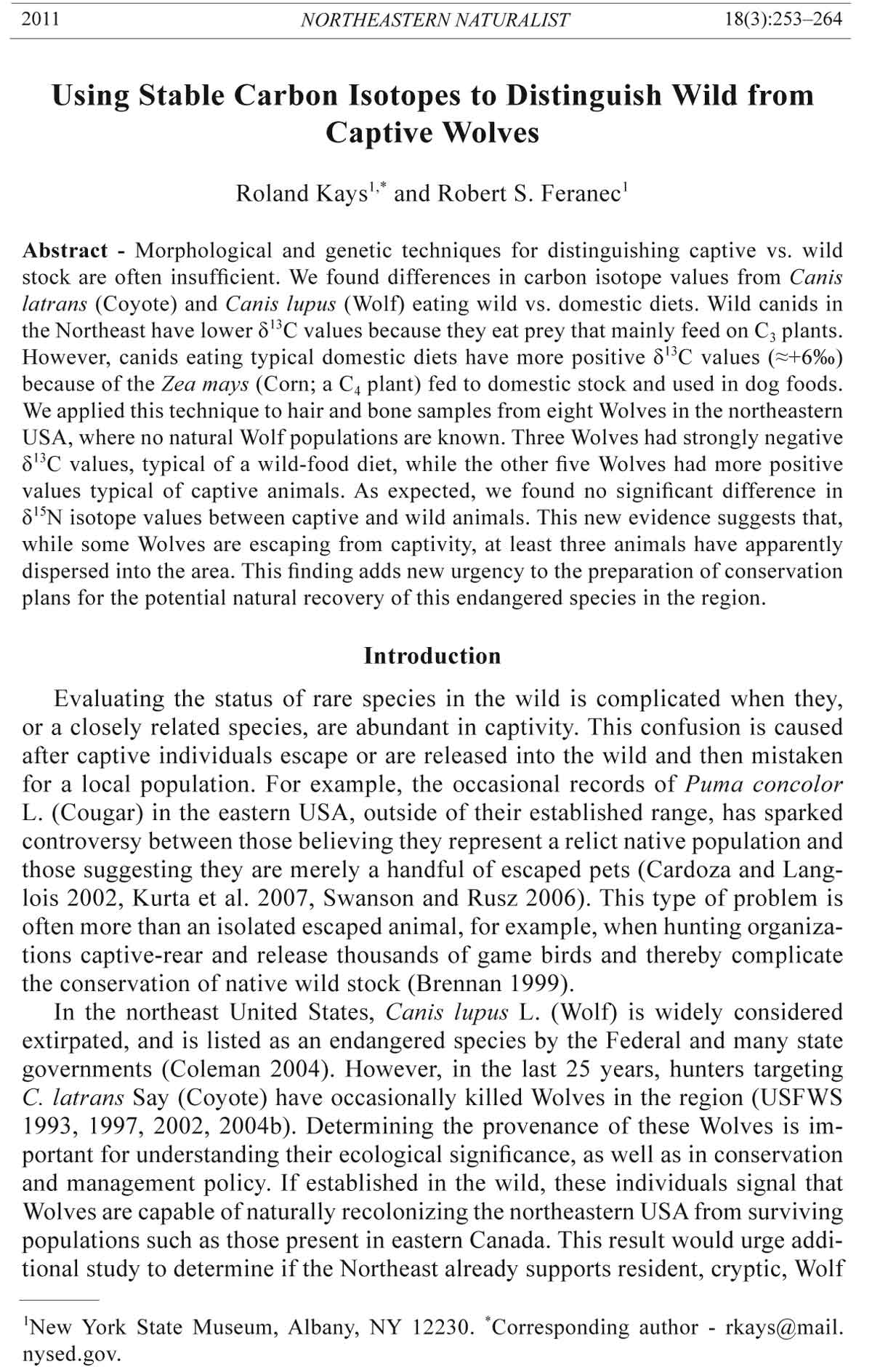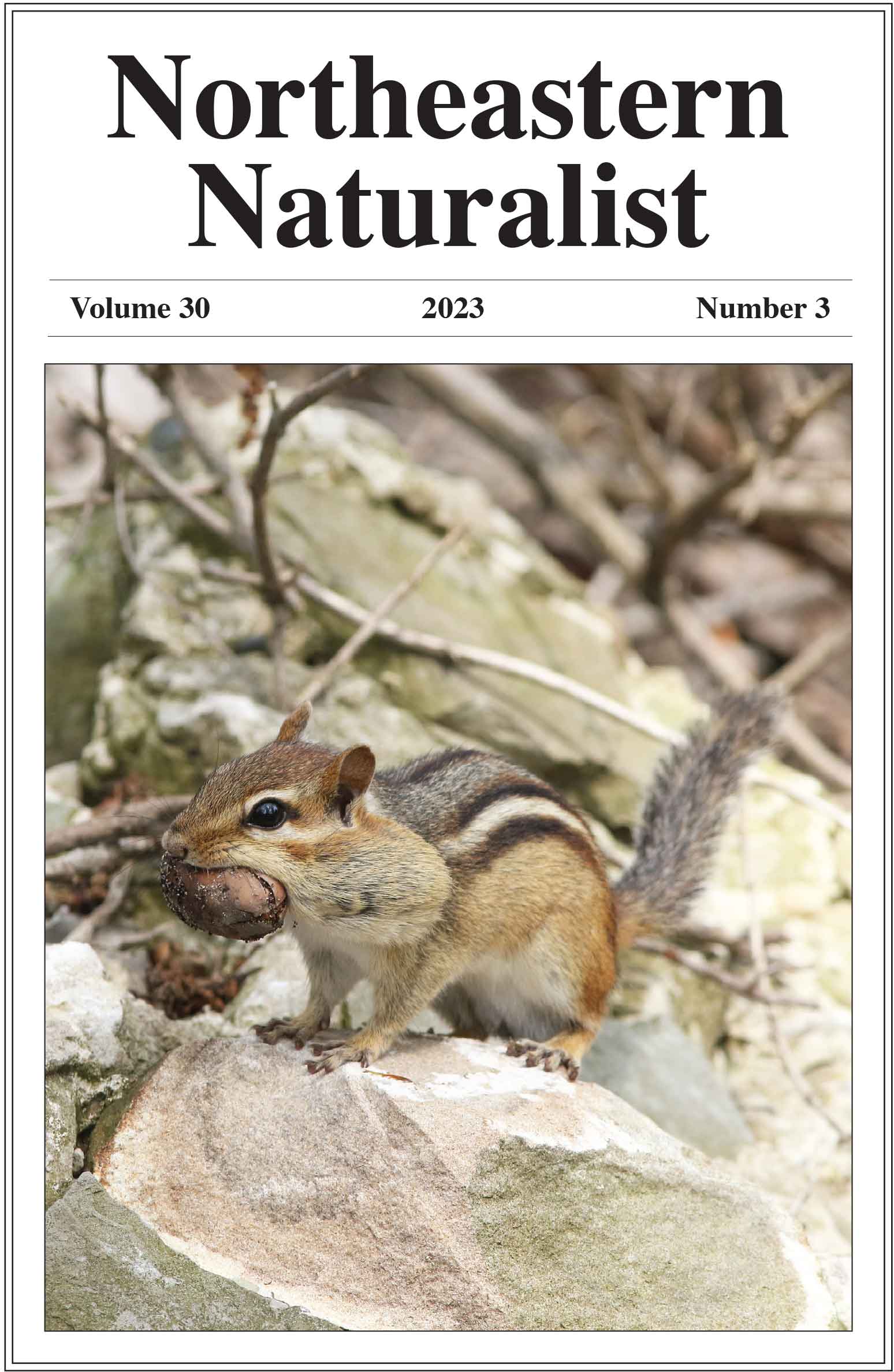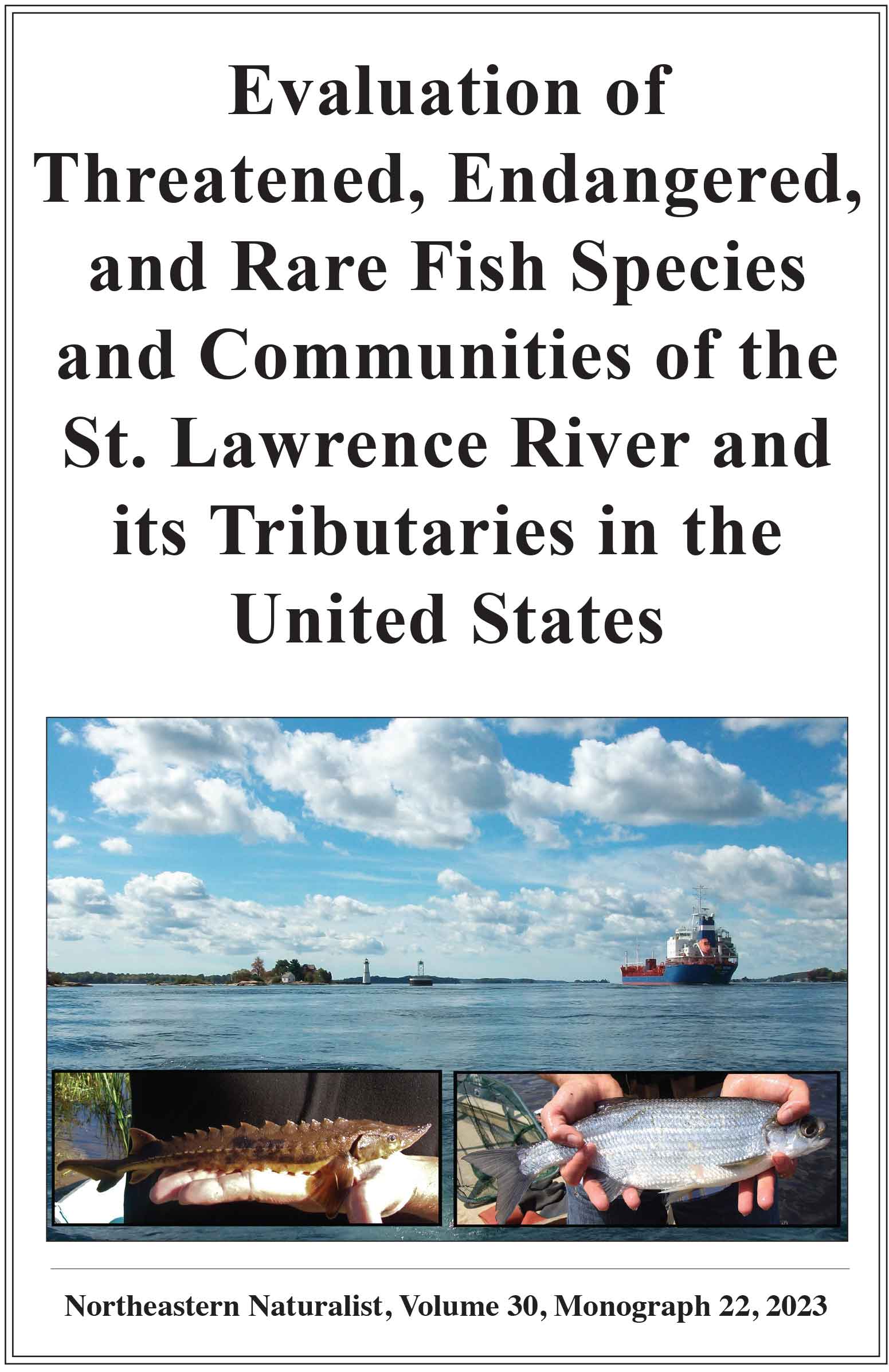2011 NORTHEASTERN NATURALIST 18(3):253–264
Using Stable Carbon Isotopes to Distinguish Wild from
Captive Wolves
Roland Kays1,* and Robert S. Feranec1
Abstract - Morphological and genetic techniques for distinguishing captive vs. wild
stock are often insufficient. We found differences in carbon isotope values from Canis
latrans (Coyote) and Canis lupus (Wolf) eating wild vs. domestic diets. Wild canids in
the Northeast have lower δ13C values because they eat prey that mainly feed on C3 plants.
However, canids eating typical domestic diets have more positive δ13C values (≈+6‰)
because of the Zea mays (Corn; a C4 plant) fed to domestic stock and used in dog foods.
We applied this technique to hair and bone samples from eight Wolves in the northeastern
USA, where no natural Wolf populations are known. Three Wolves had strongly negative
δ13C values, typical of a wild-food diet, while the other five Wolves had more positive
values typical of captive animals. As expected, we found no significant difference in
δ15N isotope values between captive and wild animals. This new evidence suggests that,
while some Wolves are escaping from captivity, at least three animals have apparently
dispersed into the area. This finding adds new urgency to the preparation of conservation
plans for the potential natural recovery of this endangered species in the region.
Introduction
Evaluating the status of rare species in the wild is complicated when they,
or a closely related species, are abundant in captivity. This confusion is caused
after captive individuals escape or are released into the wild and then mistaken
for a local population. For example, the occasional records of Puma concolor
L. (Cougar) in the eastern USA, outside of their established range, has sparked
controversy between those believing they represent a relict native population and
those suggesting they are merely a handful of escaped pets (Cardoza and Langlois
2002, Kurta et al. 2007, Swanson and Rusz 2006). This type of problem is
often more than an isolated escaped animal, for example, when hunting organizations
captive-rear and release thousands of game birds and thereby complicate
the conservation of native wild stock (Brennan 1999).
In the northeast United States, Canis lupus L. (Wolf) is widely considered
extirpated, and is listed as an endangered species by the Federal and many state
governments (Coleman 2004). However, in the last 25 years, hunters targeting
C. latrans Say (Coyote) have occasionally killed Wolves in the region (USFWS
1993, 1997, 2002, 2004b). Determining the provenance of these Wolves is important
for understanding their ecological significance, as well as in conservation
and management policy. If established in the wild, these individuals signal that
Wolves are capable of naturally recolonizing the northeastern USA from surviving
populations such as those present in eastern Canada. This result would urge additional
study to determine if the Northeast already supports resident, cryptic, Wolf
1New York State Museum, Albany, NY 12230. *Corresponding author - rkays@mail.
nysed.gov.
254 Northeastern Naturalist Vol. 18, No. 3
populations. Confirmation of natural Wolf populations would further encourage
additional measures to protect this endangered species and plan for their recovery.
On the other hand, if these animals are all escaped pets, the natural recovery of
Wolves to the region would not appear as imminent, and planning for their recovery
would then be a lower priority than for other endangered species.
Traditionally, classifying Wolves as pets relies on physical signs of an animal
being penned up. These signs include overgrown claws, being overweight, and/or
having tarter buildup on the teeth. However, these characters are not perfect since
some captive situations and diets may not affect claws or cause tarter build up,
while some wild animals may naturally show different levels of these conditions
(USFWS 2004a).
Isotopic analysis offers an additional tool for determining the origin of a
specimen because it gives an indication of animal diet. Herbivores acquire an
isotopic value from the plants they eat, and this value is reflected up the food
chain as predators consume herbivores (DeNiro and Epstein 1978a, Koch 1998,
Lee-Thorp et al. 2000, Tieszen et al. 1979, Vogel 1978). This technique has been
used to document the evolution of domestication by comparing isotopic values
of archeological specimens (Barton et al. 2009, Hu et al. 2009, Minagawa et al.
2005, Noe-Nygaard et al. 2005). We suggest that, by establishing isotopic differences
between domestic and wild foods from samples of known origin, this tool
could also be applied to modern conservation questions. In particular, we suggest
that the isotopic values of hair and bone samples could help determine if an
animal had spent substantial time in captivity.
Isotopic values in mammalian tissues are a reflection of an individual's diet
averaged over the metabolically active time for a specific tissue (Ambrose 1991;
DeNiro and Epstein 1978b, 1981; Sealy et al. 1987, 1995). Accordingly, the isotopes
in hair represent the average diet of an individual since its last molt, while
bone collagen typically represents a longer-term average, possibly over 20 years
(Stenhouse and Baxter 1979, Wild et al. 2000), which would typically be the full
life of a Wolf (Mech 1974).
In this study, we focused on addressing whether the analysis of stable carbon
and nitrogen isotope ratios can be used as an additional test to determine whether
Wolves from northeastern USA were captive (e.g., pets) or likely from a wild
stock. Our goal was to identify discrete differences in diet between captive and
wild canids, not necessarily the more detailed composition of the specific items
in their diet. We focused on carbon and nitrogen stable isotopes because we
suspected that they should be different between typical wild animal and captive
animal diets. Carbon, in particular, should show dramatic differences because
native foods in the northeastern USA are primarily C3 plants (with more negative
C-isotope values), while typical captive diets are based on C4 agricultural
foods, primarily Zea mays L. (Corn), and generally have more positive C-isotope
values (Cormie and Schwartz 1994; Keelan and Keelan 2009; Sage et al. 1999a,
b; Wolfe 2008). Nitrogen stable isotopes are influenced by trophic position and
conditions of the local habitat (e.g., climate and vegetation type), as well as
whether commercial fertilizer has been used to grow the food (Ambrose 1991,
DeNiro and Epstein 1981, Fox-Dobbs et al. 2007, Heaton 1986, Minagawa and
Wada 1984, Roth and Hobson 2000, Sealy et al. 1987). In addition to testing this
2011 R. Kays and R.S. Feranec 255
method with samples of known origin, we also tested a series of potentially recolonizing
Wolves from the northeast USA, and herein discuss the implications
of our results for the conservation of Wolves in the region.
Methods
To test the accuracy of using stable carbon and nitrogen isotope values to distinguish
captive from wild animals, we analyzed the isotopic value of bone collagen
of 24 wild canids from natural areas in New York (14 Coyotes), New Hampshire
(5 Coyotes), and Ontario (5 Wolves), as well as 6 captive canids from New Hampshire
(Silver and Silver 1969) whose remains are now archived at the Museum of
Comparative Zoology. The captive animals were fed a scrap beef and kibbled dog
food diet typical for captive Coyotes and Wolves. Because urban canids often eat
different diets (Fedriani et al. 2001), we also sampled 8 wild canids from urban and
suburban Massachusetts. To quantify the isotopic values of foods for northeastern
canids, we analyzed three species of wild fruit (many canids eat fruit in the fall) as
well as the bone collagen isotope values of 5 species (30 total samples) of medium
and large mammals that typically dominate their wild diet (Hamilton 1974, Potvin
et al. 1988, Sears et al. 2003). As representatives of domestic foods, we analyzed
a variety of store-bought meat and commercial dog foods typical of captive canid
diet (Silver and Silver 1969). The species and locations for all samples are detailed
in Supplemental Appendix 1 (available online at https://www.eaglehill.us/NENAonline/
suppl-files/n18-3-974-Kays-s1, and, for BioOne subscribers, at http://
dx.doi.org/10.1656/N974.s1).
We sampled the bone collagen and/or hair samples of 8 Wolves shot in the
northeastern USA between 1984 and 2008 (Table 1). Each of these animals was
substantially larger than eastern Coyotes (average = 12–18 kg [Kays and Wilson
2009], max = 23 kg [R. Kays, unpubl. data]) and classified as a Wolf (C. lupus)
or possible Wolf hybrid by state and/or federal wildlife officials. In two cases
(NY84, NY05; Table 1), physical conditions suggested the animal had been in
captivity, but no evidence of a captive past was noted for the others (USFWS
1993, 1997, 2002, 2004b). In one case (ME93), the hunters who shot the Wolf
were prosecuted for taking an endangered species (USFWS 1993).
To obtain bone collagen stable isotope values, we followed the general
methodology of Sealy et al. (1987). Briefly, pieces of bone were placed into 0.5
N hydrochloric acid at room temperature to remove the mineral portion of the
bone, generally 24 to 48 hours. Samples were rinsed with distilled water, then
decanted once the mineral portion of the bone was fully dissolved. To remove
any lipids, these samples were placed in a mixture of chloroform, methanol, and
water (ratio of 2:1:0.8 by volume) following Bligh and Dyer (1959). Once the
lipids were removed, the samples were washed and freeze-dried. Hair samples
were first mechanically cleaned and washed with distilled water. To remove lipids,
the chloroform, methanol, water mixture was used as done for the collagen
samples. Hair samples were then air dried. Both collagen and hair samples were
then loaded into tin cups and analyzed using a Carlo Erba elemental analyzer attached
to a Micromass Europa Mass Spectrometer at the Center for Stable Isotope
Biogeochemistry at the University of California, Berkeley, CA. Samples were
corrected to NIST 1577b (bovine liver).
256 Northeastern Naturalist Vol. 18, No. 3
The results of the isotopic analyses are expressed in standard δ-notation: X =
[(Rsample/Rstandard) - 1] × 1000, where X is the δ13C or δ15N value, and R = 13C/12C or
15N/14N, respectively. In this study, δ13C values are reported relative to the V-PDB
standard, while δ15N values are reported relative to atmospheric N2. The average
difference for replicate analyses was 0.2‰ for carbon, and 0.4‰ for nitrogen.
Because there is a discrimination of isotope values as food is consumed, we
adjusted the δ13C and δ15N values to more directly compare the results of the
Wolves in our study to their food sources. To make the correction, we converted
isotope values using isotopic discriminations for both collagen and hair. Collagen
has been shown to be +5.0‰ enriched in δ13C from food, while the δ15N
value was +3.0‰ enriched (Minegawa and Wada 1984, Schoeninger and Deniro
1984). For hair samples, we followed Roth and Hobson (2000), who showed an
enrichment in canid δ13C values of +2.6‰ from consumed food, while δ15N was
+3.2‰.
We compared the isotope values for groups of specimens using Tukey’s
HSD test.
Results
We observed statistically significant differences between the δ13C values of
captive and wild canids (P < 0.0001) and between domestic and wild foods (P less than
0.0001). No statistical differences were observed between the δ13C values of captive
canids and domestic foods (P = 0.094), or between wild canids and wild foods
(P = 0.115). More important than statistical differences, however, is the lack of
overlap in the δ13C values between known wild and known captive canids (Fig.
1A). As expected, wild canids and wild food had more negative carbon isotope
values, reflecting the incorporation of the native C3 plant signal. In comparison,
the captive canids and domestic foods had more positive carbon isotope values
(Table 1), reflecting the inclusion of C4 plants (primarily Corn) in the commonly
available prepared food (e.g., pet foods) or in the feed for domestic livestock. A
sample of suburban and coastal canids from MA (Table 1) showed δ13C values
that were statistically similar to the captive canids (P = 0.327) and statistically
different from the wild canid group (P < 0.0001).
When comparing nitrogen isotope values, each group was statistically similar
to each other, except for wild foods, which were statistically different from all
Table 1. Stable carbon and nitrogen isotope values for captive and wild canids and their food. Isotope
values reported in permil (‰).
Samples Mean δ13C δ13C range Mean δ15N δ15N range
Category analyzed (n) (SD) (min, max) (SD) (min, max)
Food
Domestic 14 -18.2 (3.4) -25.6, -10.7 5.1 (1.2) 2.5, 7.2
Wild 42 -27.8 (1.8) -33.3, -24.0 1.0 (1.7) -3.5, 4.3
Canids
Captive 6 -20.6 (1.1) -21.6, -18.9 6.5 (1.1) 5.4, 8.5
Urban 8 -22.5 (1.5) -24.9, -20.9 6.1 (1.2) 4.5, 7.4
Wild 24 -26.7 (1.1) -30.2, -24.6 4.7 (1.3) 0.9, 7.0
2011 R. Kays and R.S. Feranec 257
other groups. Domestic foods and wild foods were statistically different (P less than
0.0001), while there was no difference between captive canids and wild canids
(P < 0.0534). The captive canids and domestic foods displayed δ15N values more
positive than wild canids and wild foods (Table 1, Fig. 2B). However, there is
overlap among samples in δ15N values from all analyzed groups.
To isotopically identify Wolves with unknown provenance, we compared
carbon isotope values obtained from their hair or bone collagen to the known
groups (i.e., captive or wild). We defined the two groups as any values within
Figure 1. (A) Stable carbon isotope values for canids of known provenance and their
food. (B) Stable carbon isotope values for canids of unknown provenance.
258 Northeastern Naturalist Vol. 18, No. 3
two standard deviations of the mean, and values greater than two standard deviations
outside both groups were identified as ambiguous. Among the Wolves
of unknown provenance, five (ME 93, ME 96, NY 08, NY 05, NY 84) had more
positive δ13C values, implying a history of eating domestic foods (Fig. 1B).
Therefore, we categorize these as having been held in captivity for a substantial
portion of their life. Interestingly, while the bone collagen value (-18.4‰) from
Wolf ME 96 shows that the diet for most of its life was likely developed in captivity,
the hair sample had a much more negative δ13C value (-24.8‰), suggesting
it had a diet of wild food at the time of its last molt. Three other Wolves (NY 01,
Figure 2. (A) Stable nitrogen isotope values for canids of known provenance and their
food. (B) Stable nitrogen isotope values for canids of unknown provenance.
2011 R. Kays and R.S. Feranec 259
VT 98, VT 06) had δ13C values of bone collagen indicative of a wild diet (i.e., predominantly
C3), and are classified as being wild canids. Two of the three wolves
(NY 01, VT 98) that we classified as being wild canids had hair δ13C values that
fell between the groupings, and these individuals would be classified as ambiguous
if we were to use hair alone. However, for NY 01, the average hair δ13C value
was -24.5‰, which falls into the wild canid category. For VT 98, while the hair
value is considered ambiguous, two collagen samples clearly fall within the wild
canid category. For this canid, we suggest that the more positive δ13C values in
the hair sample may result from having a slightly more mixed history of eating
domestic and wild foods since its last molt.
Because there was a lack of significant differences observed among canid
groups in δ15N values (Fig 2A), it was not possible to distinguish which Wolves
of unknown origin were captive or wild based on the observed nitrogen isotope
values (Fig 2B).
Discussion
There are limited options for determining if animals have been held in captivity.
Physical signs of captivity that may result from animals walking on concrete, or
from limited exercise or food choices (Duman 2001), may not be evident depending
on the exact conditions of its captivity, and may also appear in wild populations
(USFWS 2004a). By examining hair (i.e., a record of recent dietary history) and
bone collagen (i.e., a record of diet over many years), we found that the analysis of
carbon stable isotopes can be used as an additional tool to evaluate the history of an
animal. We show that this method can help distinguish Wolves of unknown provenance
as being either captive or of wild origin. In our sample of eight unknowns,
isotope data imply that five individuals were primarily raised in captivity, and three
others were of wild origin. Interestingly, our data suggests that one of the Wolves
was raised in captivity (ME 96) but later survived on wild foods at least during its
last molt. This finding matches observations of large Wolf footprints in the area approximately
one year before the animal was shot (W. Jakubas, Maine Department
of Inland Fisheries and Wildlife, Bangor, ME, pers. comm.). Thus, our results support
the idea of using stable isotope analysis, particularly of carbon isotopes, as an
additional tool to distinguish wild animals from those with a captive history.
Limitations of the method
It is important to understand the reasons carbon isotopes are different in our
samples of wild and captive canids in order to recognize the situations in which
this test will work, and those in which it will not. In this study, we are able to
distinguish wild from domestic Wolves because Corn is the only substantial food
source of C4 plant material in this region (Keelan and Keelan 2009; Sage et al.
1999a, b). Where native C4 plants are more abundant, such as more arid biomes,
this technique may not be as discriminating. Further, in some urban and suburban
areas, even where C3 plants are naturally dominant, wild animals may incorporate
substantial amounts of typically domestic food in their diet, and thus could have
a more positive carbon isotope value (Fedriani et al. 2001). For example, our
sample of coastal and suburban canids from MA displayed higher carbon isotope
260 Northeastern Naturalist Vol. 18, No. 3
values more typical of captive animals. This result does not affect the test of
potential immigrant Wolves since they were not living in urban areas, but does
point out when this type of analysis can be problematic.
Although it is possible that native wild herbivores consuming Corn in the
region could acquire more positive carbon isotope values, all available data suggest
this is not happening at levels significant enough to affect our test. None of
the Odocoileus virginianus Zimmermann (White-tailed Deer) we tested show any
isotopic signature of eating substantial amounts of Corn. Although it is apparent
that deer eat Corn, these isotopic data, as well as data from other more comprehensive
studies (Cormie and Schwartz 1994, Maynard et al. 1935), have shown
that Corn is, at most, a seasonal resource for deer in the northeast USA. In the
most wide-ranging study of deer isotope values across North America, Cormie
and Schwartz (1994) showed that deer typically eat a diet of native plants and
very rarely have isotopic values typical of having consumed agricultural Corn.
Finally, even if one or two odd Corn-fed deer were occasionally consumed by
a wild Wolf in the northeast, its average isotope value would not change substantially
since Wolf packs typically kill and eat ca. 100 deer each year, not to
mention other prey species (Fuller 1986, Kolenosky 1972).
Wild Wolves and Coyotes do occasionally hunt livestock, which could also
increase their carbon isotope values if livestock was a substantial portion of their
diet. However, such a diet is not typical for canids, and even in areas with few native
prey and abundant livestock, most (85%) Wolf diet consists of wild animals
(Chavez and Gese 2005). Furthermore, individual predators that target domestic
animals are typically killed by ranchers before they can consume enough livestock
to alter their carbon isotope values (Mech 1998, Musiani et al. 2003).
Alternatively, Wolves kept in captivity could have more negative δ13C values
if they were fed wild foods all their lives. We did not test this possibility, but
note that it would be quite a challenge to provide the 635–1011 kg of wild meat
needed annually by a single Wolf (Glowacinski and Profus 1997). It would also
be possible to obtain more negative carbon isotope values from certain dog foods,
since, from our data, a very limited number of dog foods do have depleted δ13C
values. However, we feel that this scenario is unlikely due to the amount of food
needed by a Wolf; the less expensive dry dog foods, which generally have corn
as a major ingredient, would be more typical for a captive Wolf.
Thus, our results show that the analysis of carbon isotopes from mammal tissues
can be used to distinguish typical captive diets from typical wild diets in
C3 ecosystems. This technique is not foolproof; it could be confounded by wild
animals specializing on corn-fed prey, or captive animals fed only wild prey.
However, these are exceptional situations that our data show are rare. This technique
could be useful for clarifying other muddled conservation situations, such
as the status of Cougars in the northeastern USA (Cardoza and Langlois 2002,
Swanson and Rusz 2006) and the effect of captive-reared game birds on native
populations (Brennan 1999).
Implications for regional Wolf conservation
Wolves were extirpated from the northeastern USA by the late 1800s (Coleman
2004), but survive to the north in Ontario and Québec, and have recently
2011 R. Kays and R.S. Feranec 261
been expanding to the west in the Great Lakes (Cook et al. 1999, Potovin et al.
2005). Our results suggest that at least three wild Wolves were living in Vermont
and New York in the last 10 years. Given these relatively few Wolf records scattered
over many years and states, we do not think these represent an established
breeding population, but are probably natural migrants. Another five recent eastern
Wolves had isotope values typical of animals held in captivity, showing that
not all Wolf records represent natural migrants.
There is substantial suitable Wolf habitat in northern New York and New
England that could support a viable population of Wolves (Harrison and Chapin
1998, Mladenoff and Sickley 1998). The distance between surviving Wolf
populations in Canada and this suitable habitat in northeastern states is relatively
small when compared with potential Wolf dispersal distances (70–230 km;
Harrison and Chapin 1998). Our data suggest that three animals may have successfully
dispersed into the area. The recent recovery of Wolves throughout much
of the Great Lakes region (USFWS 2007), and increased protection of Wolves in
Ontario (Patterson and Murray 2008), make it likely that even more Wolves will
migrate into the northeastern USA in the near future.
It is important to note that there is essentially no conservation plan for northeastern
Wolves, and thus no guidelines for promoting their recovery. The most
relevant plan is over 18 years old and actually focuses on Great Lakes Wolves
(Eastern Timber Wolf Recovery Team 1992). Our data suggest that Wolves have
been naturally dispersing into the northeastern USA. If these were to become
established, this new top predator would probably reduce Coyote populations
in the region, and change the behavior and densities of prey (Berger et al. 2001,
Ripple and Beschta 2004). Based on this information, we suggest that state and
federal wildlife managers should recognize that Wolves are likely dispersing into
the area, and that there is a need for a revised conservation plan.
Conclusions
Carbon isotope values showed statistically significant differences among captive
and wild canids and their food in northeastern USA. Importantly, the δ13C
values between known captive canids and known wild canids did not overlap,
showing that this technique can help distinguish whether individual Wolves occurring
in northeastern USA were wild immigrants or escaped pets. Analysis of
nitrogen isotope values did not aid in distinguishing between captive and wild
canids. Of the eight Wolf specimens that had unknown provenance, five individuals
displayed more positive δ13C values typical of having spent much of their
lives in captivity while three others showed more negative δ13C values typical of
a wild diet. These data suggest that at least three Wolves naturally dispersed into
the northeastern USA. This recent Wolf dispersal, combined with earlier work
showing that suitable Wolf habitat exists, suggest a pressing need for the development
of Wolf conservation plans for the region.
Acknowledgments
Thanks to all the state wildlife officials who helped us obtain and sample specimens
including Will Staats, Kim Royar, Mike Amaral, Gordon Batcheller, and Walter Jakubas.
262 Northeastern Naturalist Vol. 18, No. 3
Thanks to the trappers who provided us specimens from New York, and the Museum staff
and volunteers who prepared them: Joe Bopp, Daniel Bogan, Abigail Curtis, and Paul
Gallery. We also thank Ward Stone and staff at the NYS Wildlife Pathology Lab, and Judy
Chupasko and the staff at the Harvard mammal collections for facilitating our visit and
sampling key specimens for us. This research was funded by the New York State Museum.
Literature Cited
Ambrose, S.H. 1991. Effects of diet, climate, and physiology of nitrogen isotope abundances
in terrestrial foodwebs. Journal of Archaeological Science 18:293–317.
Barton, L., S.D. Newsome, F.-H. Chen, H. Wang, T.P. Guilderson, and R.L. Bettinger.
2009. Agricultural origins and the isotopic identity of domestication in northern
China. Proceedings of the National Academy of Sciences 106:5523–5528.
Berger, J., J.E. Swenson, and I.L. Persson. 2001. Recolonizing carnivores and naive prey:
Conservation lessons from Pleistocene extinctions. Science 291:1036–1039.
Bligh, E.G., and W.J. Dyer. 1959. A rapid method of total lipid extraction and purification.
Canadian Journal of Biochemistry and Cell Biology 37:911–917.
Brennan, L.A. 1999. Northern Bobwhite, Colinus virginianus. The Birds of North
America 397:1–28.
Cardoza, J.E., and S.A. Langlois. 2002. The Eastern Cougar: A management failure?
Wildlife Society Bulletin 30:265–273.
Chavez, A.S., and E.M. Gese. 2005. Food habits of Wolves in relation to livestock depredations
in northwestern Minnesota. American Midland Naturalist 154:253–263.
Coleman, J.T. 2004. Vicious: Wolves and Men in America. Yale University Press, New
Haven, CT.
Cook, S.J., D.R. Norris, and J.B. Theberge. 1999. Spatial dynamics of a migratory Wolf
population in winter, south-central Ontario (1990–1995). Canadian Journal of Zoology
77:1740–1750.
Cormie, A.B., and H.P. Schwartz. 1994. Stable isotopes of nitrogen and carbon of North
American White-tailed Deer and implications for paleodietary and other food web
studies. Palaeogeography, Palaeoclimatology, Palaeoecology 107:227–241.
DeNiro, M.J., and S. Epstein. 1978a. Carbon isotopic evidence for different feeding patterns
in two hyrax species occupying the same habitat. Science 201:906–908.
DeNiro, M.J., and S. Epstein. 1978b. Influence of diet on the distribution of carbon isotopes
in animals. Geochimica et Cosmochimica Acta 42:495–506.
DeNiro, M.J., and S. Epstein. 1981. Influence of diet on the distribution of nitrogen isotopes
in animals. Geochimica et Cosmochimica Acta 45:341–351.
Duman, B. 2001. Differentiating Great Lakes area native wild Wolves from dogs and
Wolf-dog hybrids. Earth Voices, LLC, Howell, MI.
Eastern Timber Wolf Recovery Team. 1992. Recovery plan for the Eastern Timber Wolf.
US Fish and Wildlife Service, Minneapolis-St. Paul, MN.
Fedriani, J.M., T.K. Fuller, and R.M. Sauvajot. 2001. Does availability of anthropogenic
food enhance densities of omnivorous mammals? An example with Coyotes in southern
California. Ecography 24:325–331.
Fox-Dobbs, K., J.K. Bump, R.O. Peterson, D.L. Fox, and P.L. Koch. 2007. Carnivorespecifi
c stable isotope variables and variation in the foraging ecology in modern and
ancient Wolf populations: Case studies from Isle Royale, Minnesota and La Brea.
Canadian Journal of Zoology 85:458–471.
Fuller, T.K. 1986. Population dynamics of Wolves in North-Central Minnesota. Wildlife
Monographs 105.
Glowacinski, Z., and P. Profus. 1997. Potential impact of Wolves Canis lupus on prey
populations in eastern Poland. Biological Conservation 80:99–106.
2011 R. Kays and R.S. Feranec 263
Hamilton, W.J. 1974. Food habits of the Coyote in the Adirondacks. NY Fish and Game
Journal 21:177–181.
Harrison, D.J., and T.G. Chapin. 1998. Extent and connectivity of habitat for Wolves in
eastern North America. Wildlife Society Bulletin 26:767–775.
Heaton, T.H.E. 1986. Isotopic studies of nitrogen pollution in the hydrosphere and atmosphere:
A review. Chemical Geology 59:87–102.
Hu, Y.W., F.S. Luan, S.G. Wang, C.S. Wang, and M.P. Richards. 2009. Preliminary attempt
to distinguish the Domesticated Pigs from Wild Boars by the methods of carbon and nitrogen
stable isotope analysis. Science in China Series D: Earth Sciences 52:85–92.
Kays, R.W., and D.E. Wilson. 2009. Mammals of North America. Second Edition. Princeton
University Press, Princeton, NJ.
Keelan, B., and E. Keelan. 2009. Vascular plants of the Moose River Plains and vicinity:
A taxonomic checklist. New York Flora Association. Available online at http://www.
nyflora.org/plant-lists/. Accessed 2 March 2009
Koch, P.L. 1998. Isotopic reconstruction of past continental environments. Annual Review
of Earth and Planetary Science 26:573–613.
Kolenosky, G.B. 1972. Wolf predation on wintering deer in east-central Ontario. Journal
of Wildlife Management 2:357–369.
Kurta, A., M.K. Schwartz, and C.R. Anderson. 2007. Does a population of Cougars exist
in Michigan? American Midland Naturalist 158:467–471.
Lee-Thorp, J.A., J.F. Thackeray, and N.A. van der Merwe. 2000. The hunters and the
hunted revisited. Journal of Human Evolution 39:565–576.
Maynard, L.A., G. Bump, R. Darrow, and J.C. Woodward. 1935. Food preferences and
requirements of the White-tailed Deer in New York State. Joint contribution of the
New York State Conservation Department and New York State College of Agriculture
1:1–35.
Mech, L.D. 1974. Canis lupus. Mammalian Species 37:1–6.
Mech, L.D. 1998. Estimated costs of maintaining a recovered Wolf population in agricultural
regions of Minnesota. Wildlife Society Bulletin 26:817–822.
Minagawa, M., and E. Wada. 1984. Stepwise enrichment of 15N along food chains: Further
evidence and relation between δ15N and animal age. Geochimica et Cosmochimica
Acta 48:1135–1140.
Minagawa, M., A. Matsui, and N. Ishiguro. 2005. Patterns of prehistoric Boar Sus scrofa
domestication, and inter-islands Pig trading across the East China Sea, as determined
by carbon and nitrogen isotope analysis. Chemical Geology 218:91–102.
Mladenoff, D.J., and T.A. Sickley. 1998. Assessing potential Gray Wolf restoration in
the northeastern United States: A spatial prediction of favorable habitat and potential
population levels. Journal of Wildlife Management. 62:1–10.
Musiani, M., C. Mamo, L. Boitani, C. Callaghan, C.C. Gates, L. Mattei, E. Visalberghi,
S. Breck, and G. Volpi. 2003. Wolf depredation trends and the use of fladry barriers to
protect livestock in western North America. Conservation Biology 17:1538–1547.
Noe-Nygaard, N., T.D. Price, and S.U. Hede. 2005. Diet of aurochs and early cattle in
southern Scandinavia: Evidence from 15N and 13C stable isotopes. Journal of Archaeological
Science 32:855–871.
Patterson, B.R., and D.L. Murray. 2008. Flawed population viability analysis can result
in misleading population assessment: A case study for Wolves in Algonquin Park,
Canada. Biological Conservation 141:669–680.
Potovin, M.J., T.D. Drummer, J.A. Vucetich, D.E. Beyer, R.O. Peterson, and J.H. Hammill.
2005. Monitoring and habitat analysis for Wolves in upper Michigan. Journal of
Wildlife Management 69:1660–1669.
Potvin, F., H. Jolicoeur, and J. Huot. 1988. Wolf diet and prey selectivity during two
periods for deer in Québec: Decline versus expansion. Canadian Journal of Zoology
66:1274–1279.
264 Northeastern Naturalist Vol. 18, No. 3
Ripple, W.J., and R.L. Beschta. 2004. Wolves and the ecology of fear: Can predation risk
structure ecosystems? Bioscience 54:755–766.
Roth, J.D., and K.A. Hobson. 2000. Stable carbon and nitrogen isotopic fractionation
between diet and tissue of captive Red Fox: Implications for dietary reconstruction.
Canadian Journal of Zoology 78:848–852.
Sage, R.F., M. Li, and R.K. Monson. 1999a. A taxonomic distribution of C4 photosynthesis.
Pp 551–584, In R.F. Sage and R.K. Monson (Eds.). C4 Plant Biology. Academic
Press, New York, NY.
Sage, R.F., D.A. Wedin, and M. Li. 1999b. The Biogeography of C4 Photosynthesis: Patterns
and Controlling Factors. Academic Press, New York, NY.
Schoeninger, M.J., and DeNiro, M.J. 1984. Nitrogen and carbon isotopic composition
of bone collagen from marine and terrestrial animals. Geochimica et Cosmochimica
Acta 48:625–639.
Sealy, J.C., N.J. van der Merwe, J.A. Lee-Thorp, and J.L. Lanham. 1987. Nitrogen isotopic
ecology in southern Africa: Implications for environmental and dietary tracing.
Geochimica et Cosmochimica Acta 51:2707–2717.
Sealy, J.C., R. Armstrong, and C. Schrire. 1995. Beyond lifetime averages: Tracing life
histories through isotopic analysis of different calcified tissues from archaeological
human skeletons. Antiquity 69:290–300.
Sears, H., J.B. Theberge, M.T. Theberge, I. Thornton, and G.D. Campbell. 2003. Landscape
influence on Canis morphological and ecological variation in a Coyote-Wolf
C. lupus x latrans hybrid zone, southeastern Ontario. Canadian Field Naturalist
117:589–600.
Silver, H.S., and W.T. Silver. 1969. Growth and behavior of the Coyote-like canid of northern
New England with observations on canid hybrids. Wildlife Monograph 17:1–41.
Stenhouse, M.J., and M.S. Baxter. 1979. The uptake of bomb 14C in humans. Pp 324–341,
In R. Berger and H.E. Seuss (Eds.). Radiocarbon Dating. University of California
Press, Berkeley, CA.
Swanson, B., and P.J. Rusz. 2006. Detection and classification of Cougars in Michigan
using low copy DNA sources. American Midland Naturalist 155:363–372.
Tieszen, L.L., D. Hein, S.A. Qvortup, J.H. Troughton, and S.K. Imbamba. 1979. Use of
δ13C values to determine vegetation selectivity in East African herbivores. Oecologia
37:351–359.
US Fish and Wildlife Service (USFWS). 1993. Serology and morphology reports on 1993
Wolf from Maine (MCZ62506). Ashland, OR.
USFWS. 1997. Morphology and serology report on 1997 Maine Wolf (MCZ62507).
Ashland, OR.
USFWS. 2002. Agency case No. 00FW01519. Ashland, OR.
USFWS. 2004a. Evaluation of tartar and shortened claws in wild-caught Wolves (Canis
lupus) in the Smithsonian's collection. Trip Report TV#99030-4-0121. Ashland, OR.
USFWS. 2004b. Saratoga county canid. Ashland, OR.
USFWS. 2007. Proposed rules. Federal Register 72:6052–6103.
Vogel, J.C. 1978. Isotopic assessment of the dietary habits of ungulates. South African
Journal of Science 74:298–301.
Wild, E.M., K.A. Arlamovsky, R. Golser, W. Kutschera, A. Priller, S. Puchegger, W.
Rom, P. Steier, and W. Vycudilik. 2000. 14C dating with the bomb peak: An application
to forensic medicine. Nuclear Instruments and Methods in Physical Research B
172:944–950.
Wolfe, E. 2008. Dog food comparison charts: Dry dog foods (kibble) grocery store/
department store foods. Available online at http://www.doberdogs.com/menu.html.
Accessed 21 September 2010.












